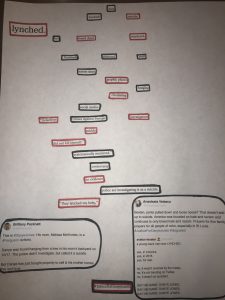Viktoria Kalmatskaya
Taylor Kantor
Katrina Nolan
Kyle Brunner
Hope: Aspiring and expecting a desired outcome
Etymology: The verb form of hope is to look forward to something while the noun form refers to a wish or expectation. This word is first recorded in Old English but is believed to originally root from the Low German domain, which then spread to Middle High German as hoffen. The verb derives from the Old English term hopian which means to have trust or confidence in something. The term is thought to have a connection with the verb hop, in connection of leaping into an expectation. The noun form derives from the Old English term hopa, which means the expectation of something desired (Hope (v.)).
A Raisin in the Sun by Lorraine Hansberry
In the book A Raisin in the Sun, hope is a reoccuring theme that motivates each character. Hope adds motivation to people’s lives and gives them the little push that is needed to achieve that outcome. An example of hope is when the play describes the environment that they live in. “Still, we can see that at some time, a time probably no longer remembered by the family, the furnishings of this room were actually selected with care and love and even hope—and brought to this apartment and arranged with taste and pride.” (26). By saying the furnishings were an epitome of hope further proves how it applies to everyone in this play. The hope in this scene is not literally in the furnishings, but the family gave it that emotion. The hope that was driven from their living space was the hope to move into a new one. Explaining the Younger house is essential to comprehending why they would want to treat themselves to a bigger, and nicer home.
Some other examples of hope in A Raisin in the Sun is the entire family’s hopes to move out and live the American Dream. During this period, only the average white family could hope to achieve this American Dream, yet the Younger’s worked to defy that standard. When the “Clybourne Park Welcoming Committee” visits the Younger’s home, Walter shows hope in saying “We come from proud people, we have all thought about your offer and we have decided to move into our house because my father earned it for us brick by brick. We will be good neighbors. We don’t want your money” (147). He declined the offer because he had hope that they could make a life work in this highly white populated neighborhood. Also, the Walter families dreams could be better achieved in the proper living environment. It was rare to see a person of color from “the ghetto” succeed. When this white man came to their home in attempt to restrain them from this success, their hope to peacefully live in an all white neighborhood decided their fate. This proves that hope is not just a theme in this book, it is a way of life.
The Case for Reparations by Ta-Nehisi Coates
Ta-Nehisi Coates’ essay “The Case for Reparations” uses multiple true stories as examples to show how unfair the government has been towards people of color. These stories are filled with so many devastating events that it seems like all hope is lost. That is not the case, however. Reparations are amends created for those who have been wronged which brings hope into their lives. After all the reparations, we have made it, somewhat, into the “postracial” society which is the idea that we have overcome issues of inequality. One example the author, Coates, uses is Clyde Ross who suffered the loss of his family’s land, car, and all of their animals because Ross’ father was accused of owing three thousand dollars in back taxes. They did not have a lawyer and could not fight against it. Clyde Ross also lost his chance for better education because he did not have access to a school bus that would get him to the better school. Many years and failures later, things finally started looking up and hope came back into Ross’s life. He started to move north to “flee the acquisitive warlords of the South. They were seeking the protection of the law.” Ross had found a job, gotten married, and had children. Coates even stated that, “When he walked down the street, he did not have to move because a white man was walking past. He did not have to take off his hat or avert his gaze.” This is a huge step up from having everything taken away from him since he was a young boy. Hope is the reason Ross never gave up fighting for his rights. Ross did not sit back and wait for things to start looking up, he had hope for the future and that is what drove him to keep fighting. Coates uses the technique of laying out all the negatives to make it seem like there is no hope and then bring light into the readers eyes again towards the end of the passage.
The Woman Warrior: Memoirs of a Girlhood Among Ghosts by Maxine Hong Kingston
The Woman Warrior, by Maxing Kingston, is the story of ghosts and the effect the dead have on the living years after they’ve moved onto another place. Kingston, throughout her novel, develops the idea that hope is nonexistent due to the people Kingston focuses on in each chapter. The one that resonates most with this theme is the “No Name Woman”, as this woman was left to time and forgotten about. It seems as though optimism is restored through Kingston’s writing, as she brings attention to this person that was seemingly lost to time and would have never been thought about again. The No Name Woman is Kingston’s late aunt, and because she is not here to the tell the story of her life to Kingston, she develops these fantasies that tell a fictional version of her life. Through Kingston’s writing, The No Name Woman is able to stay in the minds of the people and that she won’t be lost to time just yet, and that alone inspires hope within the context of the novel. In the last chapter, Kingston grows from being insecure and quiet as a little girl to using her past to let her voice be heard through her writing. The ghosts in the story represent the hauntings of each character in the chapters.
Citizen by Claudia Rankine
In Citizen: An American Lyric, Claudia Rankine pieces together poems and images that portray the African American experience when it comes to racism and microaggressions.
Although the people in these short essays experience racism, sometimes by their own friend, they often think of another possibility for why they would say such a racist comment. For example, Rankine writes, “You never really speak except for the time she makes her request and later when she tells you you smell good and have features more like a white person. You assume she thinks she is thanking you for letting her cheat and feels better cheating from an almost white person” (5). When faced with racist remarks this person still has faith, hoping that it was not intentional. Another example of hopeful thinking in the face of oppressive behavior or comments is when Rankine writes, “This friend says, as you walk toward her, you are late, you nappy- headed ho… maybe the content of her statement is irrelevant and she only means to signal the stereotype of “black people time” by employing what she perceives to be “black people language.” Maybe she is jealous of whoever kept you… you don’t know what she means” (41-42). The narrator hopes for a more positive reasoning for why her friend would make such a remark.
Where hope for racial inequality is implied, institutions like higher education often oppress African Americans. Rankine writes, “He tells you his dean is making him hire a person of color when there are so many great writers out there. You think maybe this is an experiment and you are being tested or retroactively insulted” (10). The narrator is in such disbelief of the comment that they question if the situation is an experiment. Also, “When the woman with multiple degrees says, I didn’t know black women could get cancer, instinctively you take two steps back” (45). These remarks leave the reader with the strong desire for improvement in human nature.
In conclusion, hope is important to literature because it allows sadness and despair to turn into strong will for the better. Hope allows the readers to experience empathy during difficult times or challenges. Both the characters in the short poems and the readers are only left with hope over the dissatisfaction of the present pain and struggle. Belief that a positive occurrence will happen among negative circumstances is necessary to rise above challenges. Having hope in hopeless situations is the reason the main characters in our pieces of literature overcame their battles.
Works Cited
Coates, Ta-Nehisi. “The Case for Reparations.” The Atlantic, Atlantic Media Company, 22 June 2018,
Hansberry, Lorraine A. A Raisin in the Sun: Lorraine Hansberry. GMC Distribution, 2007.
“Hope (v.).” Index, Online Etymology Dictionary
Kingston, Maxine Hong. The Woman Warrior. Perfection Learning, 1989.
Rankine, Claudia. Citizen: an American Lyric. Penguin Books, 2015.


